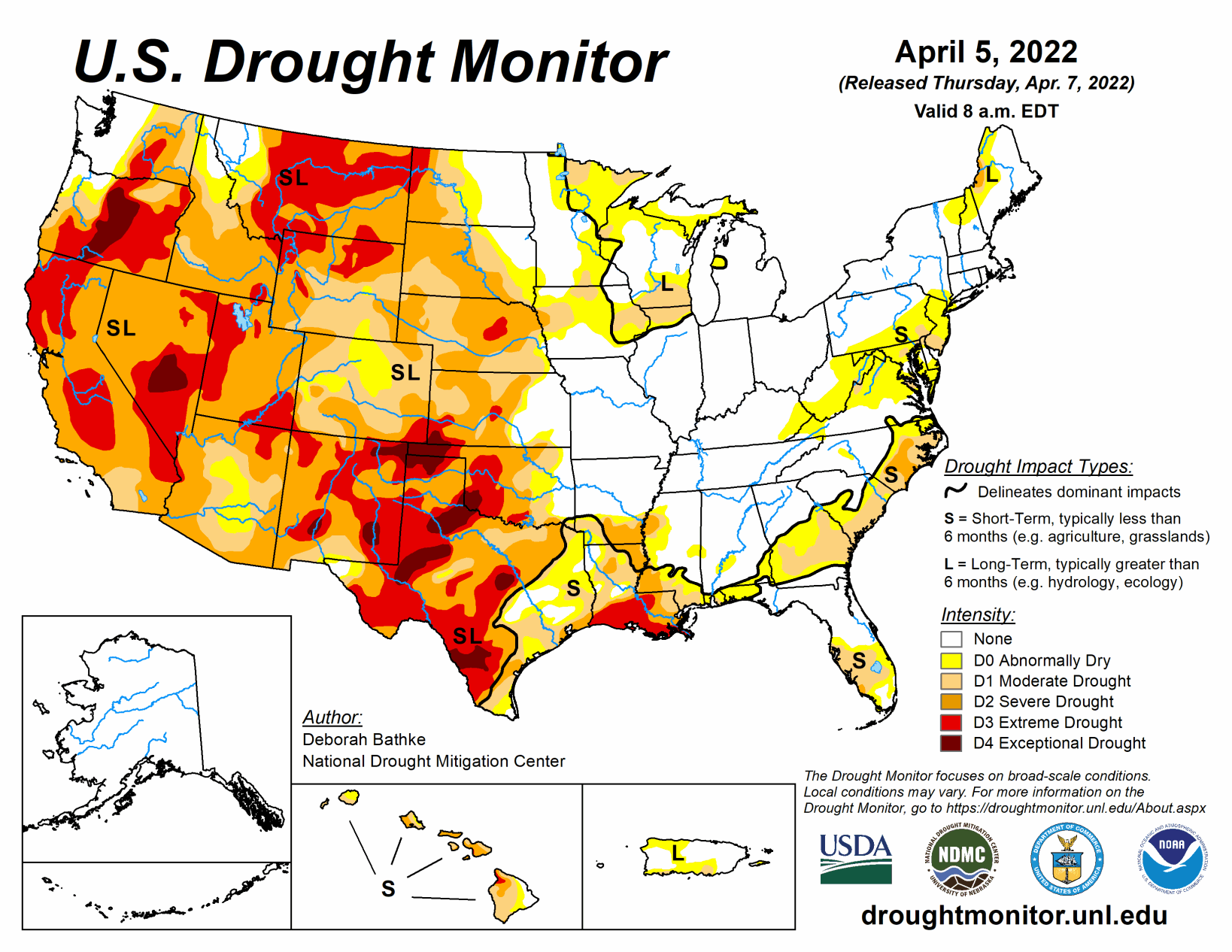Heavy rain improves conditions in parts of Midwest and South, but drought expands in the West

April brought heavy rain to parts of the Midwest, South, and Southeast, leading to broad areas of drought improvement in these regions. Meanwhile, drought expanded and intensified in the West with many locations setting records for the driest 3-month period (January to March). The High Plains remained largely unchanged this week with small pockets of improvements and degradations.
South
Like last week, the South saw drought worsen across west and south Texas and the Oklahoma Panhandle. Above-normal temperatures combined with below-normal precipitation and high winds exacerbated conditions. Drought indicators supporting the degradations include increasing precipitation deficits, dry surface and root zone soil moisture and low stream flow. One-category improvements were made to drought conditions across east Texas, southern Arkansas, north and central Louisiana and Mississippi as the effects of the recent wet pattern propagated through indicators such as streamflow, soil moisture, and vegetation. Note that the heavy, solid black line separating the part of the region experience short-term drought was modified to reflect the effects of the recent rain.
Midwest
Another week of above-normal precipitation combined with below temperatures led to more improvements across the Midwest this week. Large areas of 1-category improvements took place across the Upper Midwest where rain and snow totals of 150% to more than 300% of normal fell over the last 30 days. Short-term deficits have been erased with long-term drought remaining in areas where precipitation deficits of 6 months or longer exist and where deeper soil moisture and groundwater indicators are slower to recover.
High Plains
South-central Colorado saw a reduction in severe (D2) and extreme (D3) drought. Last week’s precipitation continued a trend of wetter-than-normal conditions that’s been in place since the start of the year. Short- and long-term indicators including precipitation, snowpack, soil moisture, and stream flow are responding to the excess moisture. Severe drought also decreased in southwest Wyoming for similar reasons. Kansas saw drought worsen in the west and improve in the east. D3 expanded in southwest Kansas, where precipitation deficits are less than 10 percent of normal over the last 60 to 90 days.
Other indicators supporting this assessment include increased evaporative demand and soil moisture. In eastern Kansas, the map depicts a continuation of improvements made last week. In south-central Nebraska, moderate drought expanded in response to increasing precipitation deficits, dry soil moisture indicators, and reports of low stock ponds. The rest of the region remained unchanged this week. State drought monitoring teams have all noted the increasing dryness across the region.
West
Parts of the Northwest saw a healthy dose of precipitation and mountain snow during the past week. In most cases, this precipitation fell over areas free from drought or simply wasn’t enough to bring relief to drought impacted areas. Only southwest Oregon saw improvement with a small decline in moderate drought (D1). Oregon also saw an expansion of drought of severe (D2) and extreme (D3) drought. Water-year-to-date (Oct. 1 to April 5) precipitation fell short and warmer-than-normal temperatures caused rapid and early melt out to the state’s snowpack.
Soil moisture and shallow groundwater indicators are reflecting the worsening conditions. In the southeast part of the state, the drought monitoring team noted impacts including extremely dry soil conditions, a lack of surface water, and poor pasture forage conditions. Central Washington, Idaho, and northwest Montana also saw increases in drought extent or severity as short-term dryness continues to build upon long-term moisture deficits extending back to last year.
Many parts of southern Idaho, and the rest of the West, have set records for the driest 3-month period (January to March) going back 100 years or more. Meanwhile near record warmth increased evaporative demand from plants and soils. Farther south, extreme drought (D3) expanded in parts of California, Nevada, and New Mexico while moderate (D1) and severe (D2) drought expanded across Arizona. In California, Cooperative Extension reports impacts to agriculture including reduced forage, livestock stress, decreased water allocation, and the selling livestock earlier than normal. Data such as reduced stream flows and declines in satellite-based vegetation health and soil moisture indicators confirm these reports.



